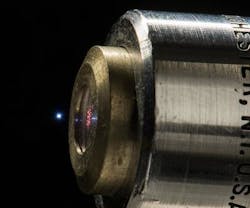Laser-induced plasma in air generates broadband terahertz radiation
Researchers at the University of Rochester's Institute of Optics (Rochester, NY) have shown that a laser-generated microplasma in air can be used as a source of broadband terahertz radiation.1 Fabrizio Buccheri and Xi-Cheng Zhang demonstrated that an approach for generating terahertz waves using intense laser pulses in air, first pioneered in 1993, can be done with much lower-pulse-energy lasers, a major challenge until now. Ph.D. student and lead author Buccheri explains that they exploited the underlying physics to reduce the necessary pulse energy for plasma generation to less than 1 μJ. He adds that it could potentially be improved for applications in the monitoring of explosives or drugs.
Applications for terahertz radiation can be divided into two categories: imaging and spectroscopy. Imaging using terahertz waves is similar to imaging using x-rays, but unlike x-rays it is not a form of ionizing radiation. For imaging applications, a narrow range of terahertz frequencies is needed, which can be generated using specific terahertz devices such as diodes or lasers. However, for spectroscopy applications, "such as analyzing food for poisons or baggage for drugs or explosives, it is useful for the terahertz radiation to be as broadband as possible," according to Buccheri. For this, a plasma is needed.
Until now, approaches to use a plasma as a broadband source of terahertz have commonly used an elongated plasma generated by combining together two laser beams of different frequencies. This technique, usually referred to as the two-color approach, requires expensive high-power lasers. The one-color approach uses a single laser frequency to generate the plasma. Pioneered by Harald Hamster and colleagues in 1993, it required even higher laser energies and therefore it was not explored further until the recent paper by Buccheri and Zhang.
Buccheri explains that he has always been interested in the polarization of light and how it can be exploited for different uses. He was interested in certain polarization states: azimuthal and radial polarization. In these states, the electric field is either perpendicular to the radial axis or radial at each given point. "I wanted to see if by creating a plasma with a laser in one of these 'weirder' polarization states I could make the terahertz emission more efficient," says Buccheri. "That didn't work. But when I understood why it didn't work, I really understood the underlying physics."
He was then able to exploit the physics to use lower laser energies than previously thought possible to generate broadband terahertz waves in air. The trick was to replace elongated plasmas, with lengths ranging from few millimeters to several centimeters, with a microplasma, about the width of a human hair. He thinks that fine tuning the type of laser used and changing the air to a different gas could enable even lower operation powers.
An advantage of this one-color approach to generating terahertz radiation is the fact that the terahertz waves propagate in a different direction from that of the laser beam, making it potentially easier to couple the terahertz waves into a waveguide on a microchip, for example.
Source: University of Rochester
RFERENCE:
1. Fabrizio Buccheri and Xi-Cheng Zhang, Optica (2015); http://dx.doi.org/10.1364/OPTICA.2.000366

John Wallace | Senior Technical Editor (1998-2022)
John Wallace was with Laser Focus World for nearly 25 years, retiring in late June 2022. He obtained a bachelor's degree in mechanical engineering and physics at Rutgers University and a master's in optical engineering at the University of Rochester. Before becoming an editor, John worked as an engineer at RCA, Exxon, Eastman Kodak, and GCA Corporation.
